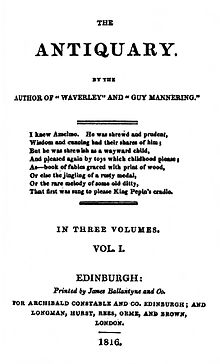
Back خبير الأثريات Arabic L'Antiquaire French Անտիկվար (վեպ) Armenian L'antiquario Italian Antykwariusz (powieść) Polish Антиквар (роман) Russian
 | |
| Author | Walter Scott |
|---|---|
| Language | English, Lowland Scots |
| Series | Waverley Novels |
| Genre | Historical novel |
| Publisher | Archibald Constable (Edinburgh); Longman, Rees, Orme, Brown and Green (London) |
Publication date | 4 May 1816[1] |
| Publication place | Scotland |
| Media type | |
| Pages | 356 (Edinburgh Edition, 1995) |
| Preceded by | Guy Mannering |
| Followed by | The Black Dwarf |
The Antiquary (1816), the third of the Waverley novels by Walter Scott, centres on the character of an antiquary: an amateur historian, archaeologist and collector of items of dubious antiquity. He is the eponymous character and for all practical purposes the hero, though the characters of Lovel and Isabella Wardour provide the conventional love interest.[2] The Antiquary was Scott's own favourite of his novels,[3] and is one of his most critically well-regarded works; H. J. C. Grierson, for example, wrote that "Not many, apart from Shakespeare, could write scenes in which truth and poetry, realism and romance, are more wonderfully presented."[4]
Scott wrote in an advertisement to the novel that his purpose in writing it, similar to that of his novels Waverley and Guy Mannering, was to document Scottish life of a certain period, in this case the last decade of the 18th century.[5] The action can be located in July and August 1794.[6] It is, in short, a novel of manners, and its theme is the influence of the past on the present.[7] In tone it is predominantly comic, though the humour is offset with episodes of melodrama and pathos.[8]
Scott included a glossary of Scottish terms as an appendix to the novel.
- ^ "The Antiquary". Edinburgh University Library. Retrieved 15 August 2022.
- ^ Baker, E. A. (1950) [1929]. The History of the English Novel. Volume 6: Edgeworth, Austen, Scott. New York: Barnes and Noble. p. 150. Retrieved 21 October 2017.
- ^ Pearson, Hesketh (1987) [1954]. Walter Scott: His Life and Personality. London: Hamish Hamilton. p. 129. ISBN 0241120055. Retrieved 21 October 2017.
- ^ Grierson, H. J. C. (1938). Sir Walter Scott, Bart. New York: Columbia University Press. p. 131. Retrieved 21 October 2017.
- ^ Shanks, Michael (2016) [2012]. The Archaeological Imagination. London: Routledge. p. 67. ISBN 9781598743616. Retrieved 21 October 2017.
- ^ Walter Scott, The Antiquary, ed. David Hewitt (Edinburgh, 1995), 444.
- ^ Brown, David (1979). Walter Scott and the Historical Imagination. London: Routledge & Kegan Paul. p. 48. ISBN 0710003013. Retrieved 21 October 2017.
- ^ Daiches, David (2005) [1960]. A Critical History of English Literature. Volume 3. New Delhi: Allied Publishers. p. 841. ISBN 8170230489. Retrieved 21 October 2017.